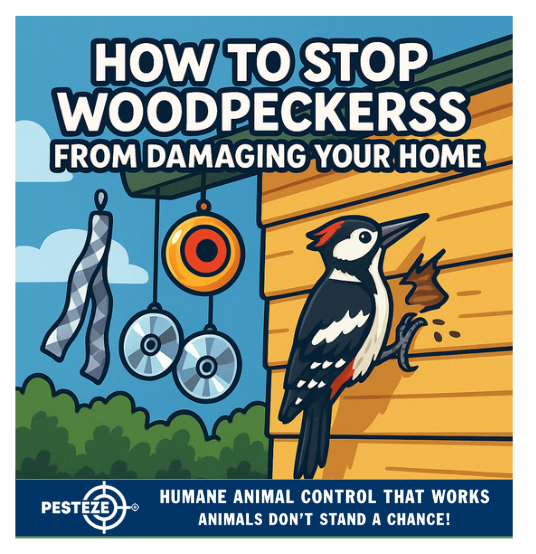HOW TO STOP WOODPECKERS FROM DAMAGING YOUR HOME

HOW TO STOP WOODPECKERS FROM DAMAGING YOUR HOME
SUMMARY
Woodpeckers peck on homes to find food, mark territory, or create nesting spots. This guide outlines humane and effective ways to deter woodpeckers while protecting your home.
FEATURES
-
Identify the cause: Food search, nesting, or territorial drumming.
-
Use visual deterrents: Reflective tape, scare-eye balloons, or shiny objects.
-
Sound repellents: Predator calls and ultrasonic devices.
-
Physical barriers: Netting or mesh over problem areas.
-
Repair damage quickly: Prevents repeated visits.
-
Call professionals: For severe or recurring infestations.
GUIDE DESCRIPTION
Woodpeckers are fascinating birds, but they can become a nuisance when they target houses. Their constant pecking creates noise, damages siding, and can lead to structural issues. To address this problem effectively, you must understand why woodpeckers are pecking and apply humane methods to stop them.
Woodpeckers peck for three main reasons: to search for insects, to create nesting cavities, or to mark their territory by “drumming.” Identifying which applies to your situation helps in choosing the right deterrent.
A simple and effective first step is to use visual deterrents. Items such as reflective tape, metallic streamers, scare-eye balloons, or even old CDs create flashes of light and movement that unsettle woodpeckers. Hanging these near damaged areas can discourage birds from returning.
Adding sound repellents can reinforce deterrence. Recordings of predatory birds, woodpecker distress calls, or ultrasonic devices make the area less welcoming. Rotating or varying sounds ensures the woodpeckers don’t get used to the noise.
Physical barriers are one of the most reliable solutions. Netting, mesh, or plastic sheeting placed over the damaged area prevents birds from reaching the siding or wood. These barriers should be installed securely to avoid gaps that persistent woodpeckers can exploit.
It’s also important to repair damage quickly. Holes made by woodpeckers can attract insects, which in turn encourage more pecking. Seal holes with wood filler, caulk, or metal flashing to reduce the risk of repeat visits.
For severe or recurring cases, professional help may be necessary. Wildlife control specialists can assess the situation, apply long-term deterrents, and ensure compliance with bird protection laws, as many woodpeckers are federally protected.
By combining visual, auditory, and physical methods, while promptly repairing damage, you can protect your home without harming these important birds. Humane strategies not only safeguard your property but also respect the role woodpeckers play in the ecosystem.
- Saneeth Thota


Comments 0